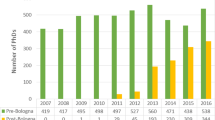Abstract
Brazilian university-based science has grown rapidly in the last 20 years. Most of the PhD-level teaching, research, and technical publications are based in the government-supported universities, although there are also privately supported universities, which educate a large fraction of Brazilian attorney, business people, and other professions. We investigate here the relationship between type of university, numbers of degree program offered, number of faculty members, and number of published papers. Twelve universities, all government supported, are found to produce a very large fraction of publications and to house the best qualified PhD programs. We find that there is a strong correlation between research carried out with foreign collaborators and rate at which the resulting publications are cited. This trend is characteristic of many developing and less developed nations.
Similar content being viewed by others
References
Lei de Diretrizes e Bases da Educação Nacional (LDB), Lei n° 9.394 de 20 de dezembro de 1996.
J. LETA, L. DE MEIS, A profile of Science in Brazil, Scientometrics, 35 (1996) 33–44.
L. DE MEIS, A. VELLOSO, D. LANNES, M.S. CARMO, C. DE MEIS, The growing competition in Brazilian science: rites of passage, stress and burnout, Brazilian Journal of Medical and Biological Research, 36 (2003) 1135–1141.
R. MENEGHINI, The key role of collaborative work in the growth of Brazilian Science in the last ten years, Scientometrics, 35 (1996) 367–373.
T. BRAUN, W. GLÄNZEL, International collaboration: will it be keeping alive East European Research, Scientometrics, 36 (1996) 247–254.
G. MELIN, O. PERSSON, Studying research collaboration using co-authorship, Scientometrics, 36 (1996) 363–377.
J. S. KATZ, B. R. MARTIN, What is research collaboration? Research Police, 26 (1997) 1–18.
A. F. J. VAN RAAN, The influence of international collaboration on the impact of research results, Scientometrics, 42 (1998) 423–428.
J. LETA, H. CHAIMOVICH, Recognition and international collaboration: the Brazilian case, Scientometrics, 53 (2002) 325–335.
ISI. Institute for Scientific Information. Database from Brazil (1981Œ2000).
INEP. Instituto Nacional de Estudos e Pesquisas Educacionais Anísio Teixeira.
C. G. SILVA, L. C. P. MELO, Ciência, Tecnologia e Inovação:desafio para a sociedade brasileira Œ Ministério de Ciência e Tecnologia, Academia Brasileira de Ciências, 2001.
CAPES. Coordenação de Aperfeiçoamento de Pessoal de Nível Superior.
UNITED NATIONS POPULATION DIVISION, World SPopulation Prospects Database.
Author information
Authors and Affiliations
Rights and permissions
About this article
Cite this article
Velloso, A., Lannes, D. & de Meis, L. Concentration of science in Brazilian governmental universities. Scientometrics 61, 207–220 (2004). https://doi.org/10.1023/B:SCIE.0000041649.24713.ca
Issue Date:
DOI: https://doi.org/10.1023/B:SCIE.0000041649.24713.ca




